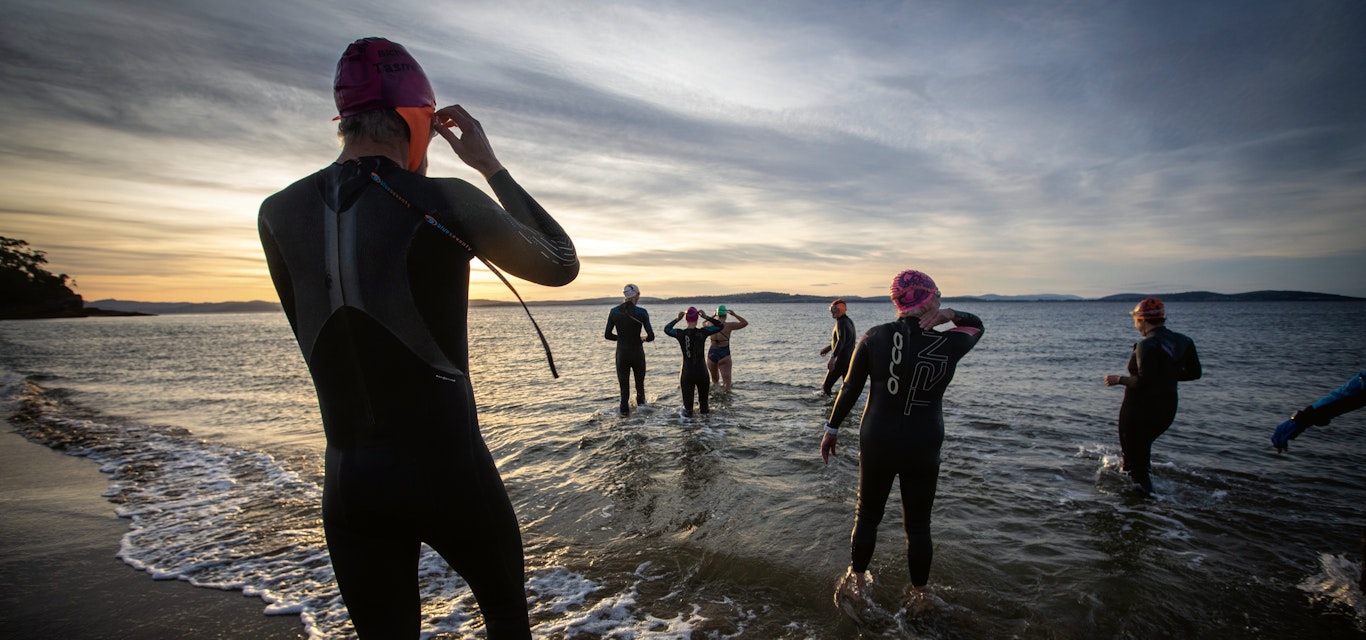Swimming for the soul
Taking the plunge in Tasmania’s bracing water is exhilarating as it is healing. Here’s why so many locals are hooked on wild swimming.
It’s a sunny June day on the Tasman Peninsula when I come off Three Capes Track feeling warm to the core after my morning hike. There’s barely a breeze but the sea percussively plays the pebbly shore of Fortescue Bay and, further along, pounds the sand. I quietly peel away from my group, strip to my merino underwear and hit the frigid waves for an invigorating 10-minute dip and dive before a rewarding sun-bask.
Fast forward a month to a windy, overcast, six-degree July morning when I join the Weedy Seadragons for their regular Saturday social ocean swim. Or, at least, that’s the plan.
The cool crowd
Driving at dawn towards Kingston in the traditional homeland of the Muwinina, I’m nagged by the thought that a scheduled cold-water winter experience is really not my modus operandi.
Even before 8am on a Saturday, Kingston Beach is bustling but the Weedies are unmissable. A group of about 25 adults, wearing wetsuits and full-length fleece-lined parkas over swimming skins, collectively buzz with the frenetic energy of people fighting the elements and sharing a challenge. I’m warmly welcomed in the bracing wind.
Spokesperson Harald Gatenby tells me the Weedies swim all year-round. Early in the pandemic, when aquatic centres closed, even more people got hooked on ocean swimming and joined them. They get a bigger summer turnout of their 150-plus members and occasionally instigate a swim to Blackmans Bay for those up for some scenic distance.
Credit: Luke Bowden
Taking the plunge
As Harald talks and I get colder, my window of opportunity to submerge closes, yet I’m quietly relieved. Swimmers who’ve been freestyling parallel to shore for more than half an hour are starting to get out but, despite the dismal weather and 12-degree water, they walk up the beach visibly hyped with eyes shining. There’s even hugging.
Ricardo Fonseca tells me a friend invited him earlier in the year. “I’ve never stopped,” he says. “I feel like a superhero. It’s invigorating and you feel energetic.” Queensland-born Hayley Kupke stands grinning against the backdrop of grey, choppy sea. “I’m addicted,” she says. “I still hate the cold, but love the ocean and the openness. It’s like I’ve achieved something every time… feels euphoric.”
“I feel like a superhero. It’s invigorating and you feel energetic.”
Credit: Rob Burnett
Is it just a trend?
So-called wild swimming is trending worldwide but, like so much wellness-related and nature-based, it’s an old practice in a new package. For many, this is simply swimming. And for palawa (First Nations peoples of lutruwita), this saltwater Country is not ‘wild’ but rather an integral part of their extraordinarily long story of health, wellbeing and genuine sustainability.
Dried-off and rugged-up Weedies recongregate in a Kingston cafe where I learn that, along with the social aspect, people take part for fitness, bragging rights and to appreciate the natural environment above and below the surface. Cath Towns joined while dealing with some trauma. “Finding [that] rhythm of breathing in the water helps me in my everyday life to find calm.”
for palawa (First Nations peoples of lutruwita), this saltwater Country is not ‘wild’ but rather an integral part of their extraordinarily long story of health, wellbeing and genuine sustainability.
Similar clubs around the state include Tomatoes Swim on Hobart’s eastern shore, Bicheno Coffee Club and the Happy Fish at St Helens. Winter Ocean and Sea Swimming Association (WOSSA), is the winter off-shoot of Taroona’s summer swim club (TOSSA) and strictly no wetsuits.
“If I wasn’t swimming in a group in winter I wouldn’t go,” says Weedy member Catherine Stringer. “Once you’ve put your things out the night before, you don’t notice the morning frost on the grass or ice on the car.” This former runner also appreciates how little equipment is required. “It’s a different sort of buzz to running. I like it better.”
